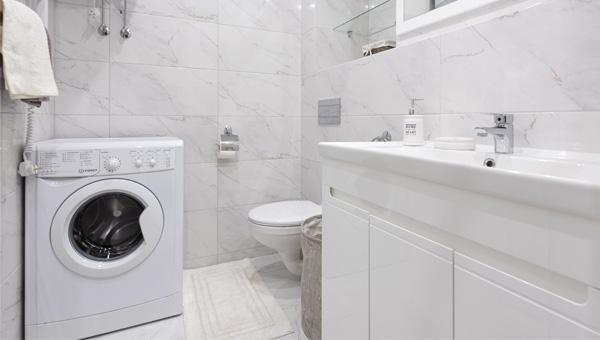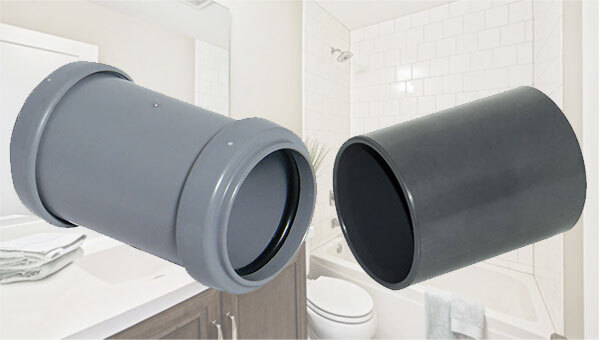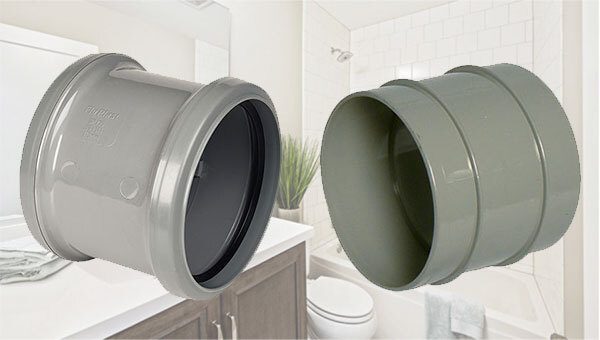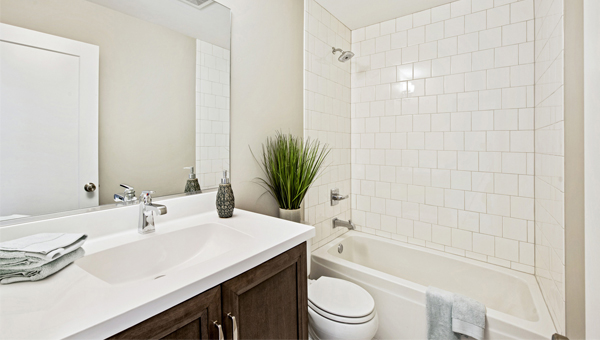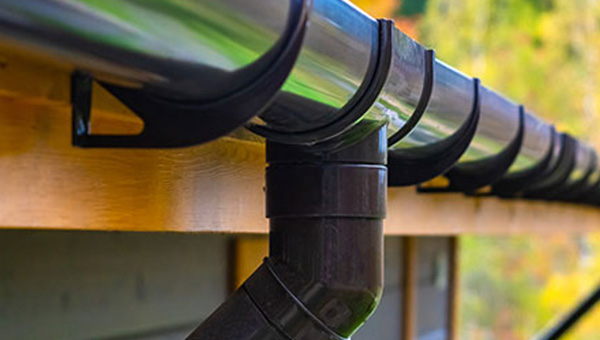
Guttering is another one of those essential aspects of the home that most of us pay very little attention to in our day-to-day lives. As long as it is doing its job of channelling rainwater away from our roofs and into the drains, there's little reason to think about it...right?
Well, unless you are really lucky, chances are that you’ll need to at least acknowledge the existence of your guttering at some point during your time as a homeowner, and probably even give them some care and attention. But what do you need to know about them? How do you identify the type of gutters you have? How do you choose the right guttering for your house if the existing system needs replacing? These are the questions we will attempt to answer for you in this article.
Introduction to guttering
Believe it or not, the humble gutter can trace its history all the way back to 1500 BC and the Indus Valley civilisation; one of the most widespread civilisations in South Asia during the Bronze Age. There, the basic concept of moving unwanted water away from a dwelling, using guttering made from burnt clay bricks, is first recorded to have been used.
It wasn’t really until much later in history, however, that gutters were used as part of a rainwater system like those we have today. Before guttering, buildings had to have overhanging roofs, or be built with the first story jutting out over the ground floor, to try and prevent rainwater from running down the walls and soaking into the footings causing damp and other water damage to the property as it did. However, these solutions would still leave a wall of water between you and your front door on a rainy day. Guttering, as it was introduced to Great Britain by the Romans, was a solution to all these problems.
Though the invention of the downpipe came later again, early gutter systems still served to direct rainwater off the roof, and away from the buildings walls and footings, in a concentrated flow of water that was much easier to avoid than a front door waterfall.
When the invention of the downpipe did then come along, the first recorded use being in 1240 on the Tower of London, it brought with it the ability to actually collect the rainwater that fell on our roofs and put it to good use.
Nowadays, almost all buildings we see have some form of guttering system to help direct rainwater away from our properties and prevent flooding. The basic design is quite simply a trough running along the base of the roof that catches the rainwater run-off and channels it towards a downspout that directs it into a drain to be carried away, or into a water tank for collection and rainwater harvesting purposes.
However, though they are indeed simple in design and purpose, guttering systems do come in a variety of materials and configurations, which can make it a bit confusing when it comes to deciding what type of guttering you need. So, whether you are planning to install an entirely new guttering system on your property, need to replace a damaged section of an existing gutter, or just want advice on how best to keep your gutters clean, this guide has you covered.
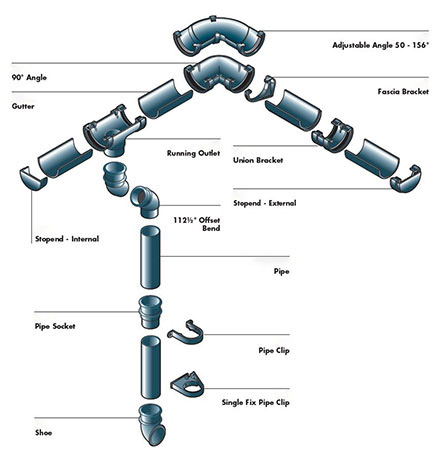
Guttering system overview
When you hear the word "guttering" you're most likely going to picture the trough, the gutter itself that runs along the edge of your roof. However, there is much more to a guttering system than just the gutter. From gutter clips and unions to support brackets and downpipe shoes, there are a number of important components that you'll want to familiarise yourself with. Below is a breakdown of all the parts you will see in a standard rainwater guttering system.
Gutter
Arguably the most important part of any guttering system, the gutter collects the rainwater that runs off the roof and channels it into a downpipe to transport it away from the property. However, for the gutter to be able to do its job, it needs support from the following components:
- Stopends - these are used to cap-off the open ends of the guttering to stop the water from being able to go anywhere but towards the downpipe. You'll find them available as either External or Internal models, which may seem confusing at first, but there is a simple explanation to differentiate the two.
- External stopends are used to cap-off gutter lengths.
- Internal stopends are used to cap-off other component pieces, such as unions, angles, or outlets, as necessary.
See our guttering system diagram for examples of this.
- Gutter Angles - these are used to facilitate a change in direction of the gutter to support it in following the shape of your roof. They are available in a variety of angles to suit most needs, including 90 degrees, 135 degrees and even some that are adjustable ones that can accommodate angles between 50 - 156 degrees.
- Gutter Unions - these are used to connect lengths of gutter together. Given that gutters tend to come in 2m or 4m lengths as standard, and the average residential home will require somewhere between 30m to 80m of guttering, you are likely to need a lot of these. Connecting lengths of gutter together isn't all they do, however, as they are designed to be fixed to the fascia board of the house and provide additional support to the joints.
- Fascia Brackets - also known as support brackets or gutter clips, these, like the gutter unions, are fixed to fascia (a maximum of 1m apart along each gutter length) to secure the gutter in place and provide support joints connecting to angles and outlets.
- Gutter Outlets - these are used to connect the gutter to the downpipe. The outlet sits slightly lower than the base of the gutter which allows the water to run out more easily. They are available in two styles:
- Running Outlet - this type of outlet is used to connect two gutter lengths together whilst also providing an outlet to the downpipe. Ideal for properties where the roof overhangs as they enable the guttering to continue past the point where connection to the drainpipe needs to be made.
- Stopend Outlet – this type of outlet has a built-in stopend to cap-off the gutter at the point of connecting to the downpipe. Ideal for systems where the guttering end up against a wall, such as around conservatories and extensions.
Downpipe
The downpipe is the controlled escape route for the water collected by the gutters. It funnels the water safely down the side of the building and into a drain where it then flows away from the property. Though not as impressive looking as the gargoyle waterspouts of old, the common downspout does do a much better job of allowing you to control where the gutter water goes. However, just like with the gutter itself, the downpipe cannot succeed without a supporting cast of the following items:
- Offset Bend – these are angular sections of pipe that are used to connect the gutter outlet to the downpipe in situations where a “swan neck” bend is required e.g. where there is an overhang between the fascia that the gutter is attached to and the wall that the downpipe is attached to. The most common types of offset bend have a 112.5 degree angle that, when two are connected together, create the “swan neck” bend.
- Hopper Head - this is a small container that attaches to the top of the downpipe and enables a waste pipe from another source to empty into the guttering system. Generally found on much older systems as they are no longer common practice to use in new installations.
- Pipe Socket – this is used to connect two lengths of downpipe together, usually with a simple pushfit connection. Some types of pipe socket are designed with an integrated bracket that allows it to be screwed into the wall to give support around the joint.
- Pipe Clip – these are used to secure the downpipe in place against the wall of the property and provide support around joints.
- Pipe Branch – this is used to connect two downpipes together into a single drop, which is useful if you need the collected water to flow into one drain. Typically designed with angles that match the standard offset bends, ensuring that the connecting pipe aligns perfectly with the branch.
- Shoe – this is fitted at the end of a downpipe to direct the water flow into a drain or gully. Also known as a spout, it is basically a truncated pipe bend that diverts the water away from the wall to prevent it from seeping into the property’s foundations. It is important to fit one of these if the downpipe isn’t being connected directly into a drain or soakaway.
The different types of guttering
Technically speaking, there are 3 different types of guttering; eaves, valley, and parapet gutters.
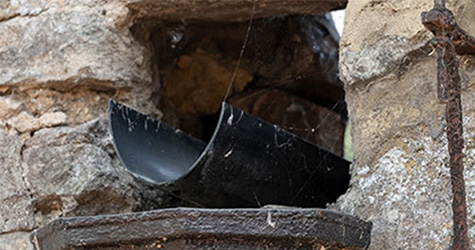
- Parapet Gutters offer drainage for flat roofs between parapet walls (i.e. walls that continue on up past the level of the roof). A gap in one of the walls allows for the gutter to drain water from the roof into a hopper fitted to a downpipe.
- Valley Gutters consist of metal flashing that runs the length of any junction between where two roofs meet, or where there is a change in direction of the roof. The flashing forms a watertight gutter channel that directs water run-off into either eaves or parapet guttering.
- Eaves Gutters are the type we’ve been describing up to now. They run along the bottom edge of a sloping roof to form a trough that channels rainwater into a downpipe. This is the most common type of guttering and, as such, is the one we will continue to focus on in this article.
When it comes to eaves guttering, there are two main choices you have to make; the type of material you want and the profile of the guttering. Unless you have an unlimited budget for your project, the type of material you choose is likely to be the most important of these two factors, as it is the one with the biggest impact on overall cost, so that’s where we’ll start.
Gutter Material Options
We often get asked the question “which is better plastic or metal gutters?”, and it would be easy to suggest that the stronger, more durable (and expensive) product would indeed be the best in the long run. But that isn’t always the case. It really is dependent on the type of building, the desired look that you require and the budget you are working too. Metal gutters can have a longer lifespan than PVC (over 50 years for copper gutters), but they tend to cost more to repair if damaged. A PVC guttering system may need to be replaced after 30 years, but is far cheaper and easier to repair.
So, since we cannot definitively answer the question “which is best” for everyone, we’ve compiled a list of the most common guttering materials along with their pros and cons.
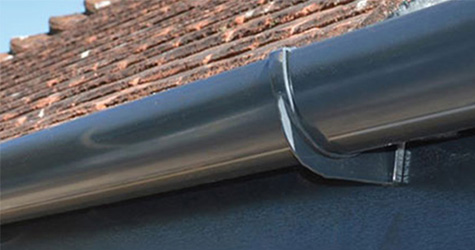
Plastic (PVC) Guttering
PVC guttering is one of the most popular types of guttering for both professionals and DIYers alike, due to its low cost, ease of instal and wide variety of profile options and colours.
Pros:
- Inexpensive
- Lightweight
- Easy to install
- Easy to repair
Cons:
- Prone to UV damage
- Colours can fade
- Susceptible to ladder damage
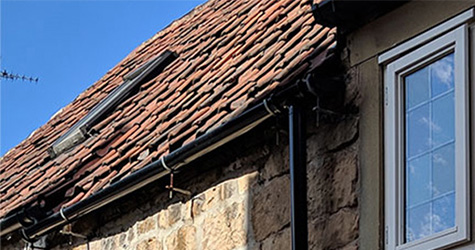
Cast Iron Gutters
Traditionally the material of choice for guttering in the UK, cast iron can still be found on many older properties and is perfect for maintaining the original look of listed buildings.
Pros:
- Unrivalled lifespan
- Exceptionally Strong
- Perfect for listed buildings
Cons:
- Very expensive
- Heavy and awkward to install
- Needs painting every 5 years
- Costly to repair or replace
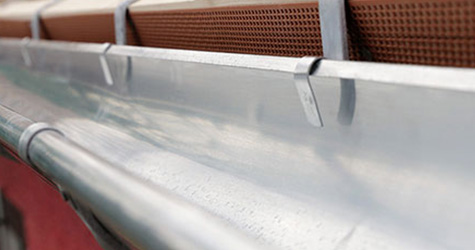
Galvanised Steel Gutters
The most affordable option in metal guttering, galvanised steel gutters provide a clean, contemporary aesthetic for modern properties.
Pros:
- Relatively inexpensive
- Strong and lightweight
- Resistant to thermal expansion and contraction
- Can be painted to suit most properties
Cons:
- Susceptible to rust
- Needs more regular maintenance
- Requires special paint to coat
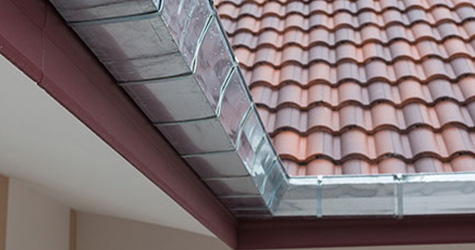
Stainless Steel Gutters
Steel guttering 2.0. Stainless steel has many of the same benefits as galvanised steel guttering but with the added advantages of rust resistance and a longer lifespan.
Pros:
- Strong and durable
- Resistant to rust
- Resistant to thermal expansion and contraction
- Retains shine for longer
Cons:
- More expensive that galvanized steel
- Heavy and awkward to work with
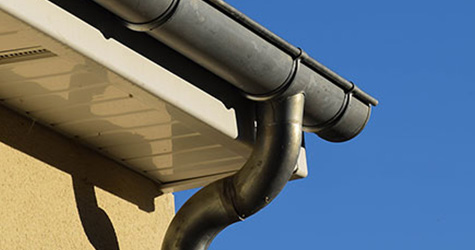
Aluminium Gutters
Recognised for its impressive high-strength/low-weight ratio, aluminium provides durable and weatherproof guttering that suits all types of buildings.
Pros:
- Strong and lightweight
- Non-corrodible
- Life expectancy of 25+ years
- Can be painted to suit most properties
Cons:
- Very expensive
- Susceptible to dents
- Needs painting every 10 years

Copper Gutters
A natural beauty that ages gracefully over time, copper guttering is a stylish choice for any property. It develops a natural weatherproofing patina, giving it a characteristic greenish blue colour, that protects it from the elements and ensures a lifespan of over 50 years with minimal maintenance needs.
Pros:
- Extremely durable
- Low maintenance
- Exceptional lifespan
- Developed a unique colour with age
Cons:
- Very expensive
- Doesn’t retain its shine

Zinc Gutters
Zinc gutters offer another stylish choice for giving your property a striking appearance. Much like copper, zinc also develops a protective patina over time, turning from a bright silver to a gun-metal grey colour.
Pros:
- Extremely durable
- Low maintenance
- Exceptional lifespan
- Lightweight
Cons:
- Very expensive
- Shine fades over time
- Not ideal in coastal environments
Gutter Profile Options
Once you have decided upon the right material for your guttering, you’ll then be faced with needing to choose the size and shape you want the gutters to be. Choosing the right size is a slightly more complex issue, as it requires you to know the size of your roof and the amount of rainwater the guttering will need to handle, so we shall cover this in more detail later on. That then leaves us looking at the shape or profile of the gutter.
While you can get custom-built fascia gutters for the right price from the right supplier, it is the most common off-the-shelf styles that we will focus on here, of which there are four types.
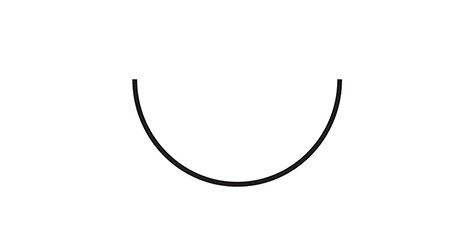
Half-round Gutters
Shaped like a tube sliced in half, this simple, traditional gutter profile is a common sight on older properties and usually one of the cheaper styles available. It isn’t very decorative but the shape does aid water flow and is suitable for properties with standard roofs. For properties with steep roofs however, or those in areas prone to higher than average levels of rainfall, half-round gutters may not be the best choice as they have a fairly shallow channel that can struggle to prevent overflow.
Pros:
- Inexpensive
- Easy to install
Cons:
- Prone to clogging with debris
- Overflow risk during heavy rain
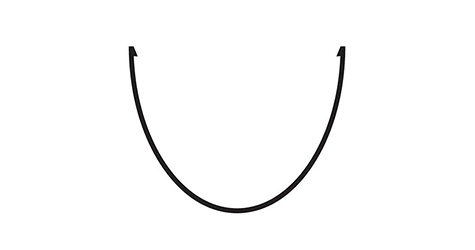
Deep Gutters
Half-round gutters evolved. Similar in appearance to the half-round, the deep gutter profile adds a deeper channel to the design to cope better with higher capacity water flow. This makes the deep gutter more suited to high sloped roofs and areas of heavy rainfall.
Pros:
- Deeper Channel
- Curved shape aids flow
Cons:
- More expensive
- Not very decorative
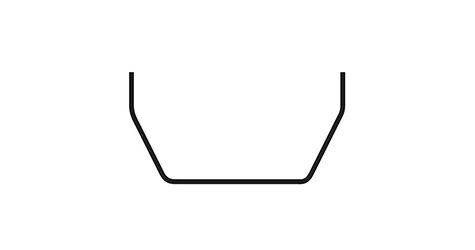
Box Gutters
The chisel-featured brother of the half-round gutter. The box gutter, also commonly known as a square gutter, is shaped like a square or rectangular box sliced in half that gives the guttering a more angular look best suited to contemporary properties. Most commonly found on commercial properties that favour function over form.
Pros:
- Deeper Channel than the half-round
- Flat sides make it easier to install
Cons:
- Can be prone to leaking at joints
- Not very decorative
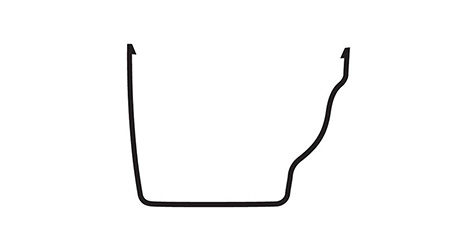
Ogee Gutters
For decorative style, the Ogee profile, or K-style as it is also known, is hard to beat. The double curved front gives off a nice crown molding effect, while the flat back and base make installation easier than the fully curved models. The intricate shape can be harder to clean, but provides a nice finish to any building.
Pros:
- Can hold a lot of water
- Very decorative
Cons:
- Harder to clean
- Can retain water longer
For more detailed information about both the material and profile options mentioned here, check out our “what are the different types of guttering” article.
What type of guttering do you need?
The answer to this question will largely depend on the age of your property and your own personal preferences on style. Technically speaking, any of the materials and profiles can be used in any (available) combination for any property; there isn’t really any right or wrong here. General consensus would say that you should use a traditional look for older properties and a contemporary look for modern properties, but the choice is ultimately yours. Unless it is a listed or heritage property, there’s nothing stopping you putting a shiny stainless steel box guttering on a Victorian-style townhouse, or cast iron half-round guttering on an ultra contemporary modern house, if that’s the look you want to go for. Just be aware that rainwater guttering can define the look and feel of your property from the outside, which could have an impact on the salability of your property should you go for a “controversial” style of guttering.
If you really don’t know what look you want for your guttering, you can’t go wrong with PVC. Plastic gutters are affordable, easy to install, look good on both traditional and contemporary properties and come in a variety of colours that allow you to match the colour scheme of your doors, windows and fascias. If that sounds like the ideal solution for your guttering needs, we’ve got you covered with our high quality range of plastic guttering and downpipes.
Aesthetics aside, however, there are a few other important considerations that could affect your choice of guttering.
Building Regulations for guttering
First and foremost, if you are installing an entirely new system, is the issue of Building Regulations. The disposal of rainwater does have some requirements outlined in the Building Regulations (Approved Document H) to ensure that any installed guttering is fit for the purpose of protecting the foundations of your property, and any adjacent properties, from rainwater damage. The most important aspect of this is stipulation that rainwater (surface water) must never be discharged into a foul drain unless your property is serviced by a combined sewer. For more information on this issue we recommend having a read of our Does your house have the right drain connections? article.
If you are building a new property, adding an extension or installing a guttering system, it’s worth speaking to your local authority for advice on their specific requirements. For minor works, repairs and maintenance of existing gutters, you usually don’t need to apply for planning permission. The exception to this however, is if you are working on a listed building, in which case you will most likely need listed building consent. You may also be restricted on what can and can’t be done to the outside of your property if you live in an area of conservation. It’s always best to check with your local council, just to be sure.
Choosing the right guttering for your roof size and shape
The size and slope of your roof does have a surprising impact on the type of guttering you will need. It is crucial that the guttering you install is able to cope with the flow of water from your roof. The larger the roof the more rainwater run-off there will be, and the steeper the slope the faster the water will flow into your gutters. If under-calculated, these two factors can cause your guttering system to fail. Shallow channel guttering, like the standard half-round profile, is limited in the capacity and flow rate it can handle and, as such, is best used on smaller properties with an effective roof area of around 40-50m2 and a roof pitch no greater than 40-50 degrees. Larger roofs and/or those with steeper gradients will require deeper channel gutters, like the Deep and Ogee profiles.
When it comes to picking out the right sized guttering system, it is important to realise that the gutters and downpipe will be sized differently. For example, if you buy FloPlast’s 112mm Half-round Gutter from us, you’ll notice that there is no 112mm downpipe to match. That is because the 112mm gutter is designed for connection to a 68mm downpipe. Why are they different sizes? The short answer is that water flows away faster vertically than it does horizontally, therefore the downpipe doesn’t need to be as wide as the gutter. Most guttering manufacturers provide a specific size downpipe to match each gutter system they make, which means that having to choose the right size downpipe isn’t something you need to really worry about. We only mention it here because we know it can be confusing when viewing a page full of guttering products.
Some gutter profiles are available in different widths too, which can be even more confusing. The key thing to remember, however, is that bigger is always likely to be better when it comes to guttering; at least in terms of their performance anyway. The downside to this tactic is that oversized gutters can look unsightly and will cost you more money than is strictly necessary. Correctly sizing up your roof really is the best way to avoid these issues. Fortunately, we have a dedicated article with step-by-step instructions on how to determine the right gutter size for your house to help with this.
It’s worth noting as well that there is such a thing as mini guttering (usually around 76mm in width) which is designed for use on small domestic projects such as garden sheds and greenhouses only. For houses, your guttering will need to be at least 100mm in width. Follow the manufacturers recommendations when picking out the pieces for your guttering system, try to avoid mixing and matching between different brands, styles and sizes and you shouldn’t have any problems.
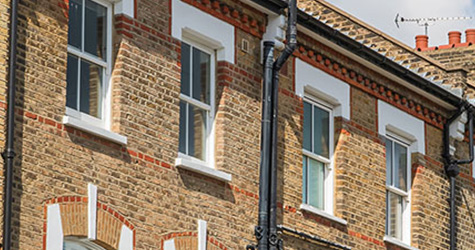
Installing guttering on semi-detached or terraced houses
What happens if your guttering joins up to the house next door? This may be a question you are asking yourself if you live in a semi-detached or terrace house, where you share one long run of gutters that deposit rainwater into separate downpipes for each property. The good news is that this doesn’t necessarily stop you all from having different style gutters, and you are each only responsible for your own section. The caveat to this is that, whatever guttering you do install, it will still have to connect to your neighbors system.
Most types of guttering do have adaptors available to connect them to other shapes and sizes, but you will need to check that the style you choose has an adaptor to match your neighbour(s). Ideally, you would need only go and ask them what style and brand their guttering is, to which they would gladly reply with all the enthusiasm of a fellow guttering enthusiast. Regrettably, the more likely scenario will involve your neighbour staring at you blankly thinking you’ve gone mad for asking such a silly question. If that is indeed the case, and your existing guttering is already different to theirs, the best thing you can do is ask if you can take a look yourself. There should be some kind of brand logo, manufacturer’s name or product code stamped, stuck, or embossed somewhere on one of the fittings to help identify it.
Once you have this information, you should be able to check the compatibility with the supplier of your chosen guttering.
Good gutters should have a good guarantee
The last point to consider is in regards to the lifespan of your guttering. At the very least, you want to get a good 10 years out of any new, correctly installed PVC guttering system (and substantially more for some of the metal systems). If a supplier or manufacturer cannot offer you a minimum 10 year guarantee on their gutters, don’t buy from them unless you fancy replacing the system again in a few years time. Always check that they have been manufactured to British Standards as well.
Once you’ve done all your research and found the best guttering system for your property, the next step is to buy it and get installed. If you decide that high quality PVC guttering is the way to go, we stock a great range of products to suit, and, if you fancy having a go at installing them yourself to save money, we’ve got you covered with a step-by-step guide on how to install guttering. Follow that up with a read through of our how to properly maintain your guttering article and you should end up with a great system, properly installed and well maintained that will prevent front door water curtains for many years to come.
Should you have any questions or need any further advice about your rainwater guttering though, check out our guttering FAQ article or contact JDP today. Our team of experts are always on hand to help with all of your drainage needs.


